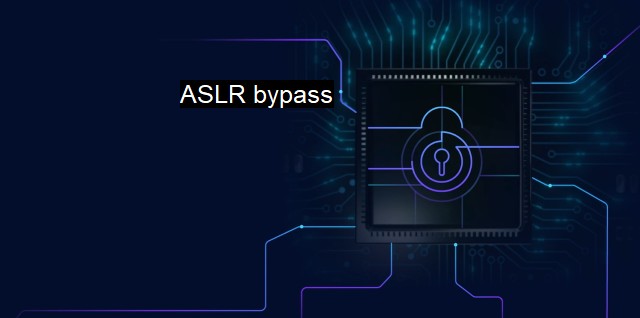What are ASLR bypass?
Advanced ASLR Bypass Techniques: Exploits for Modern Operating Systems
Address Space Layout Randomization (ASLR) is a computer security technique involved in prevention of exploitation of memory corruption vulnerabilities. Introduced in the early 2000s, the function of ASLR relies on randomized allocation of memory addresses, making it more complex to predict targetable fixed addresses. ASLR is present in multiple operating systems, heightening the difficulty of an attacker to execute a successful buffer overflow attack. This cybersecurity improvement is not foolproof, and this mastery is seen through a method known as ASLR bypass.As the name suggests, ASLR bypass refers to the strategy used to overcome the protection highlighted by Address Space Layout Randomization. It is a technique typically exercised by cyber attackers to circumvent the defensive barrier set up by ASLR. Through this bypass method, attackers can launch a triumphed exploit against the system, thereby brutally exposing its vulnerabilities.
Exploiting software through known vulnerabilities remains one of the common tactics used in cyberattacks. Initially, prior to the inception of ASLR, programs had a predetermined layout. This scenario meant an attacker could predict where executing code was placed in memory. ASLR stealthily randomizes this arrangement. without the benefit of ASLR bypass, pulling off a successful attack will be infinitely harder, equated to seeking a needle in a haystack, which makes ASLR a potent defense strategy.
An important technique frequently used to perform an ASLR bypass is called a Return Oriented Programming or ROP. Contrary to classic code injection attacks that include shellcode into a software's input, ROP exploits existing instruction sequences—referred to as gadgets—already loaded into the memory's address space. Subsequently, these instruction sequences are disproportionately navigated to carry out arbitrary operations.
Achieving a Relay-to-libc attack is another way to bypass ASLR. Etymologically, the Relay-to-libc defines an offense in the C library, to be specific a relay that requires the hacker to figure out the C library's location to be effective. Conversely, in contemporary operating systems, the code for managing system calls is present inside the system libraries, which means that the villains have a joyride in escalating to more formidable attacks like a stack overflow.
ASLR bypass can also be maneuvered via knowing a leak of memory addresses. It means that the blind attacker, who previously didn't know what he was doing, becomes location-aware and can bypass ASLR. Once the bypass tactics become successful, the progression of destructive attacks like injection of malicious codes becomes notably easier, imperiling system security.
Consequently, ASLR bypass presents challenges to antivirus systems and IT security solutions. Antivirus specifically identifies and neutralizes malicious activities based on predefined signatures. since ASLR bypass doesn't always carry an identifiably unique footprint, detecting it can be difficult for traditional antivirus programs.
In such cases, the usefulness of advanced protecting mechanisms becomes apparent. In this paradoxical cyberspace, alongside ASLR, deploying defenses like Control Flow Integrity (CFI), software sandboxing, runtime instruction checking, etc. can mitigate the threats posed by sophisticated exploits like ASLR bypass.
Despite security implementations to wrestle against vulnerability exploits, cyber-attackers continue to find ways around with leading technologies like ASLR Bypass. Consequently, this necessitates constant security enhancements and evaluations, fortified by a blend of strategy, expertise, prevailing technology, and mindfulness of the shifting paradigms within the realms of cybersecurity.

ASLR bypass FAQs
What is ASLR?
ASLR stands for Address Space Layout Randomization. It is a security technique used to prevent buffer overflow attacks by randomly arranging the location of key data areas in a program's virtual memory.What is ASLR bypass?
ASLR bypass is a technique used by attackers to circumvent the security measures of an operating system that employs ASLR. Attackers use specific tools and methods to locate the memory addresses of critical data areas that are randomized by ASLR.How can ASLR bypass affect cybersecurity?
ASLR bypass can enable attackers to execute malware on a victim's computer or network. The attackers can exploit vulnerabilities in an application by locating the randomized memory addresses and injecting malicious code into the program. This can result in data breaches, cyber attacks, and theft of sensitive information.How can antivirus software protect against ASLR bypass attacks?
Antivirus software can detect and prevent ASLR bypass attacks by identifying and blocking suspicious activity in a program's memory. The software can also alert users to potential security threats and help them take measures to secure their systems. However, hackers are constantly developing new techniques and methods to bypass antivirus software, and so it is important to keep the software updated with the latest threat intelligence.| | A | | | B | | | C | | | D | | | E | | | F | | | G | | | H | | | I | | | J | | | K | | | L | | | M | |
| | N | | | O | | | P | | | Q | | | R | | | S | | | T | | | U | | | V | | | W | | | X | | | Y | | | Z | |
| | 1 | | | 2 | | | 3 | | | 4 | | | 7 | | | 8 | | |||||||